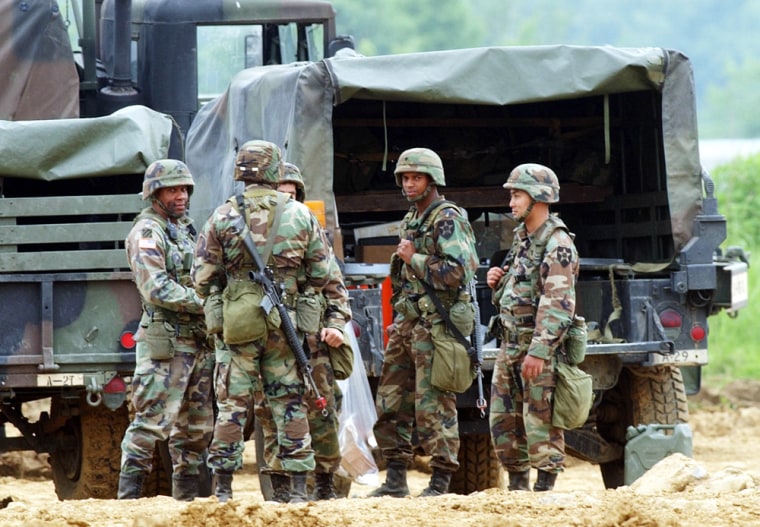A U.S. plan to cut the number of its troops in South Korea by one-third by the end of 2005 will force the South to shoulder more responsibility for defending itself against any North Korean military aggression.
The U.S. plan calls for withdrawing 12,500 of the 37,000 U.S. troops stationed in South Korea, according to a statement released Monday by the U.S. military in Seoul. The statement coincided with the beginning of talks between the two allies on another sensitive issue: moving U.S. troops farther south away from the tense border with North Korea.
Those troops were long considered a “tripwire” that would ensure U.S. intervention in the event of an attack from the North. Many in the South also see it as a healthy restraint on the United States, believing Washington won’t take military action that could provoke the North when U.S. troops are in harm’s way on the border.
The American plans augur the biggest shift in the U.S. troop deployment on South Korean soil since the early 1990s, when the two allies coordinated the removal of 7,000 U.S. soldiers. The new scheme, part of a global realignment of American forces, comes at a time of heightened tension over North Korea’s efforts to develop nuclear weapons.
“Our commitment to our treaty obligations and our ability to fulfill those commitments will remain unchanged,” State Department spokesman Adam Ereli said. “We are realigning our force posture to respond more effectively to the threats of the 21st century.”
'Further negotiations'
North Korea was silent Monday on news of the U.S. plan to withdraw troops, but some South Koreans are concerned that their communist neighbor will view the development as a sign of weakness on the part of Washington, its longtime adversary. If that is the case, North Korea could feel emboldened to push harder for concessions in the dispute over its nuclear program.
South Korea said Tuesday that the plan needs more negotiations but pledged to strengthen its military deterrent.
“We have to have further negotiations,” South Korean Defense Minister Cho Young-kil said. “Concerning concerns about a security vacuum, we will take measures to ensure that the U.S.-South Korea deterrent capability is not diminished, and we will make efforts to strengthen our deterrent capabilities.”
China, a major regional power that has preserved its traditional alliance with North Korea while developing close economic ties with South Korea, might also view a withdrawal of troops as an opportunity to expand its influence on the peninsula.
The U.S. delegation in Seoul, led by Assistant Secretary of Defense Richard Lawless, told the South Koreans the troop reduction would not affect U.S. defense capabilities in the theater because the United State plans to bring in more modern weapons systems, according to Kim Sook, head of the South Korean Foreign Ministry’s North American bureau.
The U.S. troop cut would include some 3,600 soldiers already earmarked for redeployment this summer from South Korea to Iraq, the statement said.
“Details are being worked out as the process of consultation with the Republic of Korea continues,” the statement said.
South Korea’s 650,000-member military is a modern, well-equipped force that routinely conducts joint training with its U.S. counterparts. Most of the combat-ready troops are concentrated close to the border or around Seoul.
Seoul has talked of strengthening its military to make up for the sizeable U.S. withdrawal, but no official plans have been made public.
RapprochementThe North Korean military is harder to decipher: It has a formidable arsenal of missiles and more than 1 million soldiers, but it is said to have fuel shortages and lack spare parts for its decrepit military hardware, some of which dates to the 1950s.
Even its alleged nuclear weapons are a question mark. It is unclear whether North Korea has developed the technology to launch an atomic bomb as a warhead, or would have to choose the cruder methods of dropping it from an airplane or smuggling it to its destination aboard a ship.
Many South Koreans doubt the North plans another invasion, partly because the two countries have made strides toward rapprochement in recent years.
South Korean President Roh Moo-hyun, who has advocated less dependence on the U.S. military, was elected in December 2002 with the help of young voters who were disenchanted with the United States.
But Roh has vowed to preserve the alliance between South Korea and the United States, which fought together against North Korean and Chinese armies in the 1950-53 Korean War.
“South Koreans will be very worried if the United States withdraws so many troops at a time,” Rep. Hong Jae-hyong, the chief policymaker of Roh’s ruling Uri Party, told the Yonhap news agency.
The conservative opposition Grand National Party, which has traditionally supported a U.S. military presence, described the troop cut plan as “shocking and surprising.”
South Korea had been aware of Washington’s plans to reposition or remove troops for some time. The main topic of discussion at the talks in Seoul on Monday was a separate plan to move U.S. troops away from the Demilitarized Zone between North and South Korea.
The plan unsettles some South Koreans, who suspect the United States will feel freer to carry out military action against the North if U.S. troops are not in immediate harm’s way on the border. Washington has said it has no plans to invade the North, but some in the South worry it could take a more limited action, like a strike on nuclear facilities.
Under the plan, about 7,000 U.S. forces and their families would also move from the Yongsan Base in downtown Seoul to an expanded facility south of the capital by 2006.
